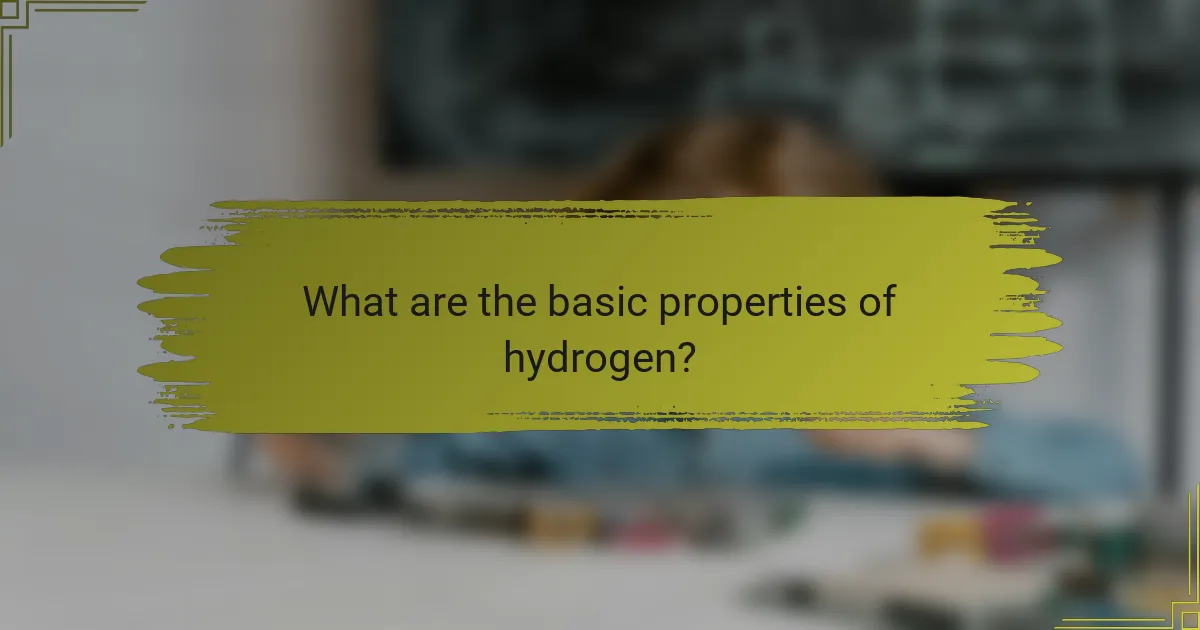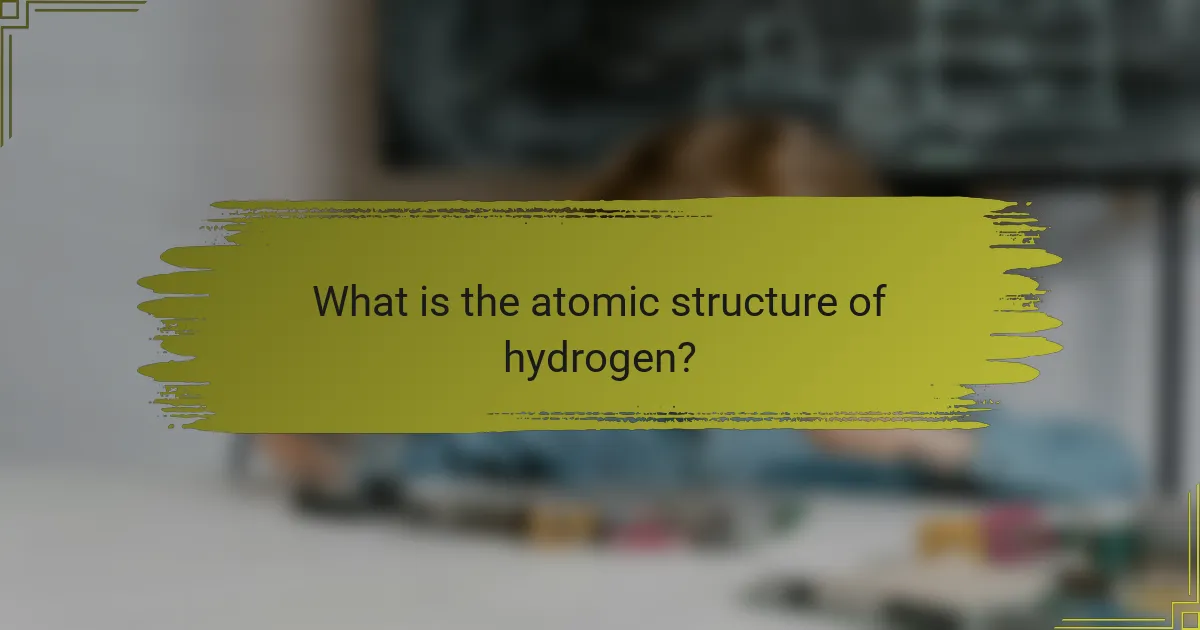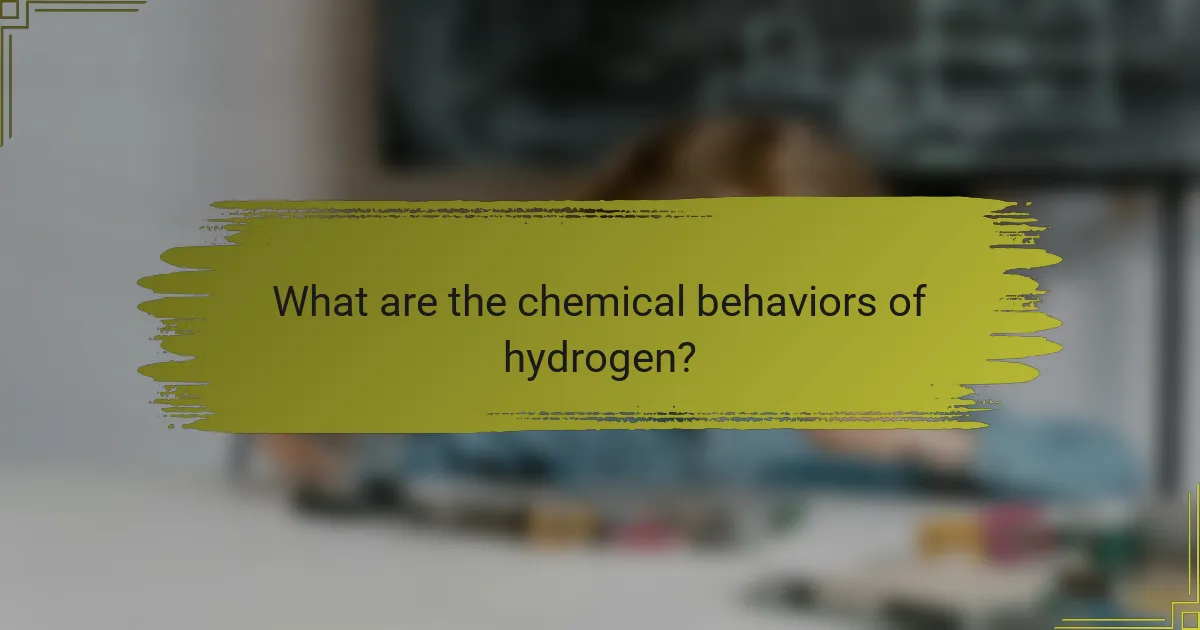
What are the basic properties of hydrogen?
Hydrogen is the simplest and most abundant element in the universe. It has an atomic number of 1 and is represented by the symbol H. Hydrogen exists primarily as a diatomic molecule (H2) under standard conditions. It is a colorless, odorless, and tasteless gas. Hydrogen is highly flammable and reacts explosively with oxygen. The molecular weight of hydrogen gas is approximately 2.016 g/mol. It has a boiling point of -252.87 degrees Celsius and a melting point of -259.16 degrees Celsius. Hydrogen plays a crucial role in various chemical reactions, including combustion and synthesis processes.
How is hydrogen classified in the periodic table?
Hydrogen is classified as a nonmetal in the periodic table. It is located in Group 1, which is known as the alkali metals group. However, hydrogen is unique and does not share the same properties as alkali metals. Its atomic number is 1, indicating it has one proton in its nucleus. Hydrogen exists as a diatomic molecule (H2) under standard conditions. It is also the lightest and most abundant element in the universe. This classification is supported by its position and properties in the periodic table.
What are the atomic number and mass of hydrogen?
The atomic number of hydrogen is 1. The atomic mass of hydrogen is approximately 1.008 amu. Hydrogen is the first element on the periodic table. It consists of one proton and one electron. The atomic mass reflects the average mass of hydrogen isotopes. The most common isotope is protium, which has no neutrons. This information is confirmed by the International Union of Pure and Applied Chemistry (IUPAC).
What are the isotopes of hydrogen and their characteristics?
Hydrogen has three isotopes: protium, deuterium, and tritium. Protium is the most common isotope, with one proton and no neutrons. It accounts for about 99.98% of hydrogen in nature. Deuterium contains one proton and one neutron. It makes up approximately 0.02% of hydrogen. Tritium is radioactive, consisting of one proton and two neutrons. Tritium is rare and occurs naturally in trace amounts. Each isotope has distinct characteristics, such as atomic mass and stability. Protium has an atomic mass of about 1 u, deuterium about 2 u, and tritium approximately 3 u.
What are the physical properties of hydrogen?
Hydrogen is a colorless, odorless, and tasteless gas at room temperature. It has a molecular weight of about 2.016 g/mol. Hydrogen exists as diatomic molecules (H2) under standard conditions. It is the lightest and most abundant element in the universe. Hydrogen has a boiling point of -252.87 °C and a melting point of -259.16 °C. It is highly flammable and supports combustion. Hydrogen is insoluble in water but can dissolve in certain organic solvents. Its density is approximately 0.08988 g/L at standard temperature and pressure.
How does hydrogen exist in different states of matter?
Hydrogen exists in three states of matter: solid, liquid, and gas. In its solid state, hydrogen forms a crystalline structure at extremely low temperatures below 14 K. Liquid hydrogen occurs at temperatures between 14 K and 20.28 K under pressure. In its gaseous state, hydrogen is found at temperatures above 20.28 K and at standard atmospheric pressure. These states depend on temperature and pressure conditions. Hydrogen’s transition between these states is governed by phase diagrams. For example, at room temperature, hydrogen is a gas. Solid hydrogen is used in cryogenic applications, while liquid hydrogen serves as rocket fuel.
What are the boiling and melting points of hydrogen?
The boiling point of hydrogen is -252.87 degrees Celsius. The melting point of hydrogen is -259.16 degrees Celsius. These values are established under standard atmospheric pressure. Hydrogen exists as a gas at room temperature. It transitions to a liquid at its boiling point. At its melting point, hydrogen becomes a solid. These temperatures are critical for understanding hydrogen’s physical properties.

What is the atomic structure of hydrogen?
The atomic structure of hydrogen consists of one proton and one electron. Hydrogen is the simplest and lightest element in the periodic table. The proton is located in the nucleus at the center of the atom. The electron orbits the nucleus in a cloud-like region called an electron shell. This configuration gives hydrogen an atomic number of 1. Hydrogen has no neutrons in its most common isotope. The presence of only one proton defines its identity as hydrogen. This structure allows hydrogen to participate in various chemical reactions, making it a fundamental building block of matter.
What is the electron configuration of hydrogen?
The electron configuration of hydrogen is 1s¹. This indicates that hydrogen has one electron in its first energy level. The ‘1’ represents the principal quantum number, which is the first shell. The ‘s’ denotes the type of orbital that the electron occupies. The superscript ‘¹’ shows there is one electron in this orbital. Hydrogen’s simple electron configuration reflects its position as the first element on the periodic table.
How does the electron configuration affect hydrogen’s reactivity?
Hydrogen’s electron configuration significantly affects its reactivity. Hydrogen has one electron in its outer shell, following the 1s¹ configuration. This single electron makes hydrogen highly reactive as it seeks to achieve a stable electron configuration, typically by forming bonds. Hydrogen readily forms covalent bonds with other elements, such as oxygen and carbon. The desire to fill its outer shell drives hydrogen to participate in various chemical reactions, including combustion and acid-base reactions. The high reactivity of hydrogen is evident in its ability to form compounds like water (H₂O) and hydrocarbons. This behavior is a direct result of its electron configuration, which influences its interactions with other atoms.
What is the significance of hydrogen’s single electron?
Hydrogen’s single electron is significant because it determines the element’s reactivity and bonding behavior. This electron allows hydrogen to form bonds with other elements, leading to the creation of various compounds. For instance, hydrogen can easily bond with oxygen to form water, a vital substance for life. The single electron also makes hydrogen a unique element in the periodic table, contributing to its classification as a nonmetal. Additionally, hydrogen’s electron configuration, 1s1, is the simplest of all elements. This simplicity underlies many of its chemical properties, such as its ability to exist in different molecular forms, including diatomic hydrogen (H2). The presence of just one electron also allows hydrogen to participate in acid-base reactions, acting as a proton donor. Overall, hydrogen’s single electron is foundational to its role in chemistry and its interactions with other elements.
How does hydrogen bond with other elements?
Hydrogen bonds with other elements primarily through covalent bonding and electrostatic interactions. In covalent bonding, hydrogen shares its single electron with another atom, forming a stable molecule. For example, in water (H2O), each hydrogen atom shares electrons with oxygen, creating a polar molecule. This polarity allows for hydrogen bonds to form between water molecules, influencing properties like high surface tension and boiling point.
Additionally, hydrogen can bond with electronegative elements such as oxygen, nitrogen, and fluorine, resulting in strong hydrogen bonds. These bonds are crucial in biological systems, such as in the structure of DNA, where hydrogen bonds hold complementary strands together. The strength and characteristics of hydrogen bonding significantly affect the physical and chemical properties of substances containing hydrogen.
What types of bonds can hydrogen form?
Hydrogen can form covalent bonds and ionic bonds. Covalent bonds occur when hydrogen shares electrons with other atoms. This sharing allows hydrogen to achieve a more stable electron configuration. For example, in water (H2O), hydrogen forms covalent bonds with oxygen. Ionic bonds can form when hydrogen donates an electron to another atom. This process creates a positively charged hydrogen ion (H+). In this state, hydrogen can interact with negatively charged ions. These bonding behaviors are fundamental to hydrogen’s chemical interactions.
How do hydrogen bonds influence molecular structure?
Hydrogen bonds significantly influence molecular structure by affecting the arrangement and stability of molecules. These bonds occur when a hydrogen atom covalently bonded to an electronegative atom experiences an attraction to another electronegative atom. This interaction leads to unique molecular geometries, such as the bent shape of water, which is crucial for its properties. Hydrogen bonds also contribute to the secondary and tertiary structures of proteins, stabilizing their shapes. The strength of hydrogen bonds, although weaker than covalent bonds, allows for dynamic interactions essential for biological processes. For example, the ability of DNA to maintain its double helix structure relies on hydrogen bonds between base pairs.

What are the chemical behaviors of hydrogen?
Hydrogen exhibits several key chemical behaviors. It readily forms covalent bonds with nonmetals. This occurs because hydrogen has one electron in its outer shell. It seeks to achieve a stable electron configuration by sharing electrons. Hydrogen can also participate in ionic bonding, particularly with highly electronegative elements like fluorine. In this case, hydrogen donates its electron, forming H+ ions. Additionally, hydrogen acts as a reducing agent in various chemical reactions. It can donate electrons to other substances. This behavior is significant in organic and inorganic chemistry. Hydrogen’s reactivity varies under different conditions, such as temperature and pressure.
How does hydrogen react with other elements?
Hydrogen reacts with other elements primarily through the formation of covalent bonds. It can combine with nonmetals, such as oxygen, to form water (H2O). Hydrogen also reacts with halogens, such as chlorine, to produce hydrogen chloride (HCl). When hydrogen reacts with metals, it can form metal hydrides. This occurs in compounds like sodium hydride (NaH). Hydrogen can also participate in oxidation-reduction reactions. For example, it can reduce metal oxides to metals. These reactions demonstrate hydrogen’s versatility in forming compounds with various elements.
What are the common reactions involving hydrogen?
Common reactions involving hydrogen include combustion, synthesis, and reduction reactions. In combustion, hydrogen reacts with oxygen to produce water and energy. This reaction is exothermic and releases heat, making it a key energy source. In synthesis reactions, hydrogen combines with other elements to form compounds, such as ammonia (NH3) from nitrogen and hydrogen. This process is crucial in fertilizer production. In reduction reactions, hydrogen acts as a reducing agent, converting metal oxides into metals. For example, hydrogen reduces iron oxide to iron in metallurgy. These reactions highlight hydrogen’s versatility in chemical processes and its significance in various industries.
What role does hydrogen play in combustion reactions?
Hydrogen acts as a fuel in combustion reactions. It combines with oxygen to produce water and energy. This reaction releases a significant amount of heat. The combustion of hydrogen is highly efficient. It produces only water as a byproduct, making it environmentally friendly. Hydrogen’s high energy content is advantageous in various applications. For example, it is used in fuel cells and internal combustion engines. The reaction can be represented by the equation: 2 H2 + O2 → 2 H2O + energy. This confirms hydrogen’s essential role in combustion processes.
Why is hydrogen considered a reducing agent?
Hydrogen is considered a reducing agent because it can donate electrons to other substances. This electron donation reduces the oxidation state of the other substances involved in a chemical reaction. In many reactions, hydrogen reacts with oxidizing agents, facilitating the reduction process. For example, in the reaction of hydrogen with oxygen, hydrogen is oxidized while oxygen is reduced. This behavior is a fundamental characteristic of hydrogen in various chemical processes. Its ability to participate in redox reactions is widely recognized in both organic and inorganic chemistry.
What are examples of hydrogen acting as a reducing agent?
Hydrogen acts as a reducing agent in various chemical reactions. One example is the reduction of metal oxides. In this reaction, hydrogen gas reacts with metal oxides to produce metals and water. For instance, hydrogen reduces iron(III) oxide to iron. This reaction is represented as Fe2O3 + 3H2 → 2Fe + 3H2O. Another example is the reduction of copper(II) oxide. Hydrogen reduces copper(II) oxide to copper, represented as CuO + H2 → Cu + H2O. Additionally, hydrogen can reduce carbonyl compounds. It converts aldehydes and ketones to alcohols in the presence of a catalyst. Overall, these examples demonstrate hydrogen’s role as an effective reducing agent in various chemical processes.
How does hydrogen’s reactivity vary under different conditions?
Hydrogen’s reactivity varies significantly under different conditions. At room temperature, hydrogen is relatively unreactive. However, when exposed to heat or a catalyst, it can react vigorously with oxygen, forming water. Under high pressure, hydrogen can form metal hydrides, increasing its reactivity with certain metals. In the presence of halogens, hydrogen readily forms halides, indicating higher reactivity. Additionally, in plasma states, hydrogen can participate in various reactions due to its ionized form. The presence of other elements and compounds also influences hydrogen’s reactivity. For instance, in acidic or basic solutions, hydrogen can participate in redox reactions, further demonstrating its variable reactivity.
What practical applications utilize the properties of hydrogen?
Hydrogen has several practical applications due to its unique properties. It is widely used in the production of ammonia through the Haber process. This process combines hydrogen with nitrogen to create ammonia, essential for fertilizers. Hydrogen is also utilized in petroleum refining, where it helps remove sulfur from fuels. Additionally, hydrogen serves as a fuel source in fuel cells. Fuel cells convert hydrogen and oxygen into electricity, emitting only water as a byproduct. Moreover, hydrogen is used in the production of methanol and as a reducing agent in various chemical reactions. Its lightweight nature makes it suitable for aerospace applications, including rocket fuel. These applications highlight hydrogen’s versatility and importance in multiple industries.
How is hydrogen used in fuel cells and energy production?
Hydrogen is used in fuel cells to generate electricity through an electrochemical reaction. In a fuel cell, hydrogen gas is supplied to the anode, where it splits into protons and electrons. The protons pass through an electrolyte membrane, while the electrons travel through an external circuit, creating an electric current. At the cathode, hydrogen protons combine with oxygen and electrons to produce water and heat as byproducts. This process is efficient and emits only water vapor, making it environmentally friendly. Hydrogen fuel cells are used in various applications, including vehicles and stationary power generation. The global market for hydrogen fuel cells is projected to grow significantly, driven by the demand for clean energy solutions.
What industries benefit from hydrogen’s chemical properties?
The industries that benefit from hydrogen’s chemical properties include energy, transportation, and manufacturing. In the energy sector, hydrogen is used as a clean fuel source. It can be produced through various methods, such as electrolysis, which separates water into hydrogen and oxygen. Hydrogen fuel cells power vehicles and provide energy for stationary applications. In transportation, hydrogen is utilized in fuel cell electric vehicles (FCEVs). These vehicles emit only water vapor, contributing to reduced greenhouse gas emissions. The manufacturing industry uses hydrogen in processes like ammonia production and petroleum refining. Specifically, hydrogen is a key component in the Haber process for synthesizing ammonia, which is essential for fertilizers. Additionally, hydrogen plays a role in refining crude oil into gasoline and other products.
What safety considerations should be taken into account when handling hydrogen?
Hydrogen is highly flammable and explosive when mixed with air. Proper ventilation is essential to prevent the accumulation of hydrogen gas. Use explosion-proof equipment to minimize ignition risks. Store hydrogen in well-ventilated areas away from heat sources and oxidizers. Personal protective equipment, such as gloves and goggles, should be worn to prevent exposure. Regularly inspect storage and handling systems for leaks. Training on hydrogen safety protocols is critical for all personnel involved. These measures are crucial to ensure safe handling and prevent accidents.
Hydrogen, represented by the symbol H and possessing an atomic number of 1, is the simplest and most abundant element in the universe. This article provides a comprehensive overview of hydrogen’s basic properties, atomic structure, and chemical behavior, including its classification in the periodic table, isotopes, physical characteristics, and reactivity. Key discussions encompass hydrogen’s electron configuration, bonding capabilities, common reactions, and its applications in various industries, emphasizing its role in energy production and safety considerations when handling this highly flammable element.
